Balanced-arm lamp: Difference between revisions
BrucePodger (talk | contribs) Add reference to usage as a character by pixar |
|||
| Line 238: | Line 238: | ||
==In popular culture== |
==In popular culture== |
||
Two desk lamps of this type feature as the main characters in the [[Pixar]] animated film [[Luxo Jr.]]. |
Two spring balanced desk lamps of this type feature as the main characters in the [[Pixar]] animated film [[Luxo Jr.]]. |
||
==References== |
==References== |
||
Revision as of 22:29, 11 April 2008
A balanced-arm lamp is a lamp with an adjustable folding arm which is constructed so that the force due to gravity is always counteracted, regardless of the position of the arms of the lamp. Many lamp brands (such as the Anglepoise and Luxo L-1 as well as other devices, such as drawing boards, use this principle.
Configuration
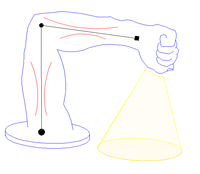
These lamp arms invite comparison with a human arm: the lamp cap is the hand, and there are three joints (equivalent to the wrist, elbow and shoulder) which connect it to the body, in this case reprsented by the base. Just as with the human arm, the advantages of the three joints are that the arm can reach virtually any point in space within a hemisphere with a radius equal to the arm's length. The same mechanism can be employed in other devices with similar requirements, such as copy holders for typists and some computer display holders. This article uses the terminology lamp cap, forearm, upper arm and base for the four basic parts of these lamps.
For the physics and theory behind balanced-arm lamps, see Classical mechanics, linkage and torque. There are different methods to balance the lamp-cap of a balanced-arm lamp. Some lamps have two coil springs working in parallel on both side of the pivoting arm. (A set of springs functions in the same way as a single spring.) Others are balanced with counterweights (a method frequently used in drawing-boards). Friction between parts of the lamp arm can also be used to maintain balance. There are a number of mechanical solutions (coupling, hydraulics and pneumatic arms) which have occasionally been used for balanced-arm lamps.
Lamps balanced with springs

There are many variations of construction with springs. Springs can be located on the mechanical equivalent of the forearm or the upper arm, or both, as well as nearer the base. Some lamps use tension springs, and others use compression springs. The image at the left shows (left to right) a compression spring at rest, then under load, followed by a tension spring at rest, and then under load. Some springs can resonate, producing low-level unwanted noise.
One Tension spring
Two Tension springs
| Two parallelograms and two tension spring sets |
|---|
 |
| One parallelogram and two extension spring sets |
|---|
A lamp like the Anglepoise lamp has one parallelogram and two extension springs. One spring controls the shortest arm of a parallelogram. Parallel to this shortest arm there is the forearm. To keep these arms parallel there are two other parallel arms (upper arm) that are controlled by a second extension spring. The lamp cap rotates the same direction as the upper arm and forearm. |
| Tension springs within the arms |
|---|
 A lamp like the Tolomeo desk lamp has no parallelograms in either arm. In this modern lamp the tension springs are hidden in the arms. The lamp cap rotates the same direction as the upper arm and forearm. |
Compression springs
| Compression springs in the arms |
|---|
 The short arms (green) stay parallel. One spring puts pull force on the blue arm. (If the blue arm is tilted back the second spring on this arm gets push force.) The blue arm controls the two parallel arms (red) that make up the upper arm. The other spring puts pull force on the other blue arm. This arm controls the forearm (magenta). The two springs can be the same size; one spring has to lift more weight but is more vertical. The other spring lifts less weight but is more horizontal. |
| Compression springs near the foot |
|---|
 One compression spring controls a very short arm (grey). The Roller chain cable connects this arm parallel to the forearm (yellow). The longer spring controls the (blue) arm. The body (red) can turn in the horizontal plane. The body is connected to a stable foot. The body can be smaller because the pressure springs can protrude below the body. |
| A compression spring with one parallelogram |
|---|
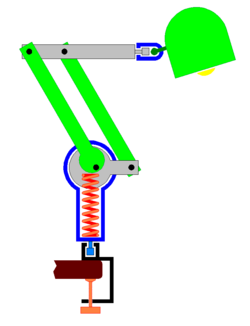 |
Other types of spring
| Spiral spring controls a pantograph arm |
|---|
| Torsion springs controls the pivoting arm |
|---|
 |
Lamps balanced by pressure and friction
| Pressure and friction lamps |
|---|
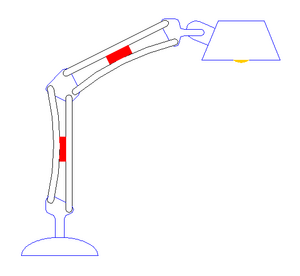  This construction is quite common in Italian lamps. Gravity causes the parallelogram to deform, making the gap between the long arms smaller. This increases pressure on the rubber in the gap, and the resulting friction holds the arm in balance. |
Lamps balanced with one counterweight
| A single counterweight |
|---|
 This construction uses a chain to keep the arm with the counterweight and the forearm parallel. The lamp-cap and counterweight move in opposite directions (both away from the base or both towards it). The balance that is required is shown by the following formula: d1 = Lamp-cap to base; m1 = weight of lamp-cap d2 = counterweight to base; m2 = weight of counterweight m1 × d1 = m2 × d2 |
| One parallelogram with one counterweight |
|---|
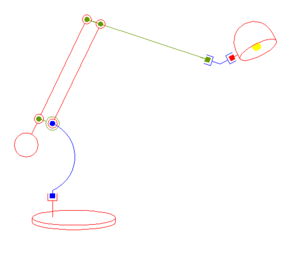 This lamp has a heavy base, with a parallelogram pantograph construction formed by bars which are all hinged on each other. One long bar extends past the parallelogram construction and has a counterweight. One short bar also extends past the parallelogram construction and holds the lamp cap. |
| One parallelogram with an extended counterweight |
|---|
 This lamp is similar to the one above, but as the counterweight has a low position, the lamp needs no heavy foot for stability: the centre of gravity is low. |
| Three parallelograms with one counterweight |
|---|
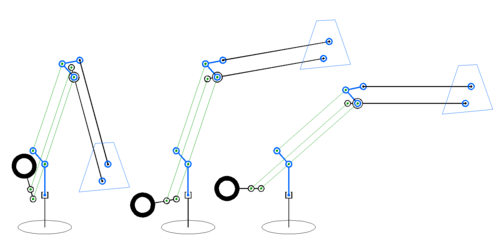 This lamp has a complex construction. |
Lamps balanced with two counterweights
| A single arm with two counterweights |
|---|
 With this lamp the movement is very limited (the arm moves up and down only) but the technique is nice to look at. As the forearm becomes more horizontal the weight ceases to be balanced on both side of the base. The weight of the base is needed to avoid over-balancing. |
| Two arms with two counterweights |
|---|
   |
Lamps using other systems
Here are some less common ways of balancing arms.
| Lamps having a vertical axis |
|---|
 |
| Friction |
|---|

 |
| Mechanical coupling devices |
|---|
 |
| Hydraulic arm |
|---|
 |
| Pneumatic arm |
|---|
 |
In popular culture
Two spring balanced desk lamps of this type feature as the main characters in the Pixar animated film Luxo Jr..
References
See also
- Engineering science and mechanics
- Industrial design
- Light fixture
- Torsion spring
- Mechanical advantage
- Mechanical engineering technology
- Moment (physics)
External links
- Dutch students from the University Delft Netherlands experimenting to balance a lamp. In Dutch but with a lot of images.
Patents history
Classifications IPC :F21V21/26
International patent category : B23B31/171
- GB191104491 An Improved Device for Supporting or Suspending Electric Lamps and the like (1911)
- U.S. patent 1,370,231 - 1921 harmonica arm -
- [1] 1923 parallelogram & counter weight
- [2] 1926 friction
- [3] 1929 2 counter weight
- [4] 1934 spring and counter weight
- FR757890 1934 CARWARDINE GEORGE
- FR784932 1935 CARWARDINE GEORGE
- [5] 1937 friction
- [6] 1938 2 parallelogram 2 springs
- [7] 1939 2 pressure springs
- [8] 19.. a-symmetric arm-lamp
- [9] 1947 friction and a spring
- [10] 1949
- [11] 1949 spring in the arm
- [12] 1954 friction arm
- [13] 1971
- EP0518569 1992
- EP1274545 2003 mechanical coupling devices




